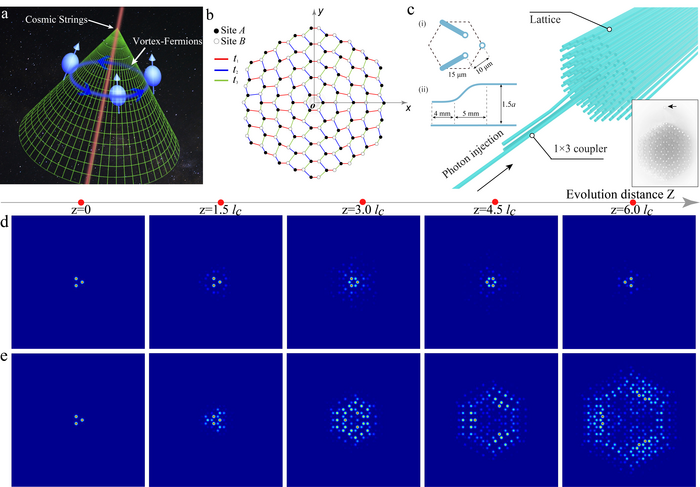The classification of geometric structures in mathematics gave rise to topology, which has since then dominated several disciplines of physics, including topological acoustics, topological optics, topological circuits, and more. Topology was initially used to describe the early electronic topological insulator.
 a, the depiction of a bound vortex of fermions in the gauge field of the cosmic string. b, the schematic of the deformed photonic graphene lattice with a position-dependent coefficient to emulate the cosmic string with a gauge field. The symbol O is the origin center of the photonic graphene lattice where the defect was located. c, the experimental schematic for exciting a series of waveguides in the innermost ring layer around the cosmic string. d, the evolution of light with angular momentum with different propagation distances in the cosmic string. e, the evolution of light without angular momentum with different propagation distances in the cosmic string. Image Credit: C. Sheng, Y. Wang, Y. J. Chang, H. M. Wang, Y. H. Lu, Y. Y. Yang, S. N. Zhu, X. M. Jin, and H. Liu
a, the depiction of a bound vortex of fermions in the gauge field of the cosmic string. b, the schematic of the deformed photonic graphene lattice with a position-dependent coefficient to emulate the cosmic string with a gauge field. The symbol O is the origin center of the photonic graphene lattice where the defect was located. c, the experimental schematic for exciting a series of waveguides in the innermost ring layer around the cosmic string. d, the evolution of light with angular momentum with different propagation distances in the cosmic string. e, the evolution of light without angular momentum with different propagation distances in the cosmic string. Image Credit: C. Sheng, Y. Wang, Y. J. Chang, H. M. Wang, Y. H. Lu, Y. Y. Yang, S. N. Zhu, X. M. Jin, and H. Liu
Theorists hypothesized that certain topological defects could have developed during a symmetry breaking of the vacuum field in the expanding universe. Here, the topology of the vacuum manifold affiliated with this symmetry breaking was not simply connected, similar to topological defects in solids, such as point defects, dislocations, and domain walls.
The cosmic string is a one-dimensional topological defect of cosmic space-time, one of these topological flaws. Efforts have been taken to look for evidence of topological flaws, such as gravitational waves produced by cosmic strings at the beginning of the cosmos.
However, with the development of transformation optics, these theoretical underpinnings of hypothetical cosmic phenomena can be broadly exploited to construct novel optical applications, such as the photonic cavity inspired by black holes and the non-diffractive beam motivated by gravitational lensing.
Chong Sheng from Nanjing University in China and colleagues recently published a new paper in Light Science & Application where they experimentally showed bound vortex light on optical chips by simulating gauge fields of cosmic strings through position-dependent coupling coefficients in deformed photonic graphene.
These cosmic string-inspired photonic lattices can also produce and transmit optical vortices, as well as manipulate the orbital angular momentum of photons on integrated optical devices. To get the comparable Hamiltonian, the study team started with the massless Dirac equation with a gauge field in the cosmic string.
They then utilized the photonic graphene lattice with the help of transformation optics by purposefully adjusting the coupling coefficient as a function of position to map the corresponding Hamiltonian.
Due to the demand for photonic lattices, distorted photonic graphene inspired by cosmic strings was built in a borosilicate glass substrate using the most recent femtosecond laser direct writing technology. It was discovered that the bound optical vortex at the defect will be generated when the single waveguide close to the defect is energized.
The distorted photonic graphene of this type, inspired by cosmic strings, can also tell apart photons from those without orbital angular momentum.
When the light with orbital angular momentum was pumped into this particular type of deformed photonic graphene, it displayed a clearly defined local confinement, in contrast to the situation without orbital angular momentum, when the light dispersed into all locations.
This research work blended both a gravitational field and a gauge field into the design of photonic devices simultaneously, strengthening the capabilities of transform optical design of photonic devices in comparison to previous designs of transformation optical photonic devices that only took into account the simulation of the gravitational field.
The disparity of orbital angular momentum in integrated photonic devices is made possible by this type of photonic device, which was inspired by the cosmic string and has a gauge field. This technology can be used for orbital angular momentum demultiplexing in future optical information technology.
Journal Reference:
Sheng, C., et al. (2022) Bound vortex light in an emulated topological defect in photonic lattices. Light: Science & Applications. doi:10.1038/s41377-022-00931-4.